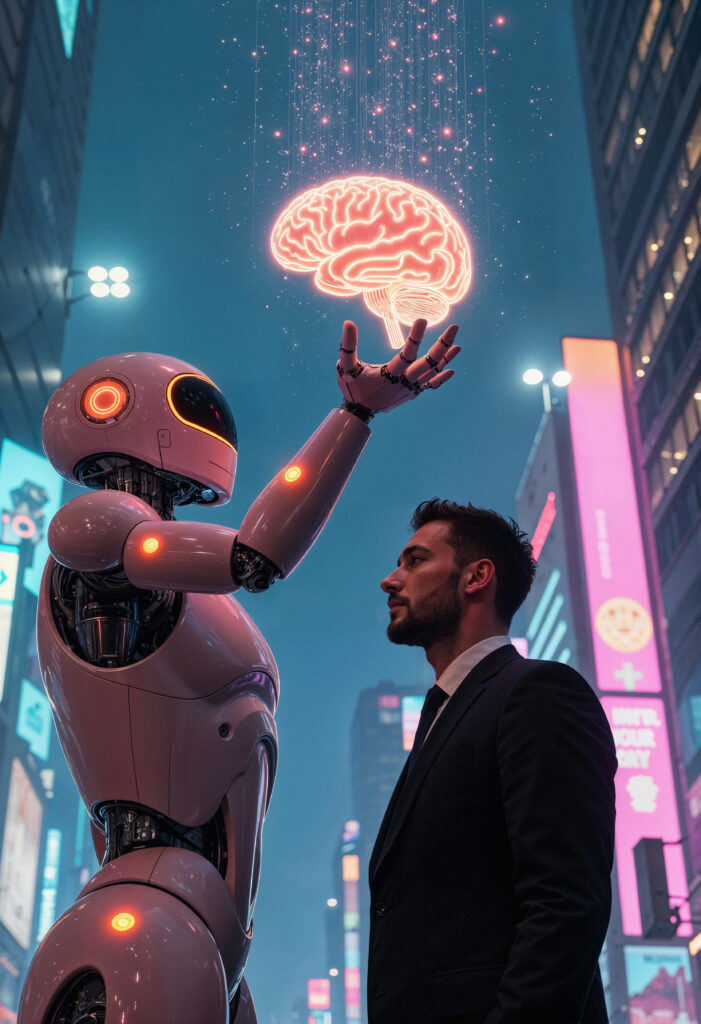Imagine waking up to a smart alarm that knows exactly when you’ll feel most refreshed. Your coffee is already brewing, your commute route is optimized to avoid traffic, and your email inbox is sorted—only the most urgent messages highlighted. All of this, powered not by magic, but by artificial intelligence (AI).
AI isn’t just science fiction anymore. It’s here, and it’s transforming nearly every aspect of our lives—how we work, communicate, heal, learn, and even think. From voice assistants like Siri and Alexa to self-driving cars and AI-generated art, intelligent systems are no longer on the horizon—they’re already shaping our daily reality.
But what does this mean for the future? Are we on the brink of a utopia where AI solves global challenges, or are we rushing toward a world where machines make decisions we can’t control? This article will explore how artificial intelligence is revolutionizing key areas like healthcare, education, business, and personal life. We’ll look at real-world examples, discuss ethical concerns, and offer practical ways you can benefit from AI today—without needing a computer science degree.
By the end, you’ll have a clearer picture of AI’s role in shaping tomorrow—and how you can stay ahead in this fast-evolving landscape. Let’s dive in.
AI in Healthcare: Saving Lives One Algorithm at a Time
One of the most profound impacts of AI is in the field of healthcare. Imagine a world where diseases are detected before symptoms appear, treatments are personalized to your DNA, and doctors have AI assistants that never get tired. That world is already beginning to take shape.
AI-powered tools are now helping radiologists detect early signs of cancer in medical images with accuracy rivaling, and sometimes surpassing, human experts. For example, Google’s DeepMind developed an AI system that can identify over 50 eye diseases from retinal scans with 94% accuracy. Early detection means earlier treatment, which can mean the difference between life and death.
But it doesn’t stop there. AI is accelerating drug discovery. Traditionally, developing a new drug takes over a decade and costs billions. With AI, researchers can simulate how molecules interact, predict side effects, and identify promising candidates in a fraction of the time. In 2023, an AI-designed drug for fibrosis entered clinical trials—marking a milestone in AI-driven medicine.
How does this affect you?
Even if you’re not a doctor or scientist, AI in healthcare means faster diagnoses, fewer medical errors, and more personalized care. Wearable devices like smartwatches now use AI to monitor heart rhythms and detect irregularities like atrial fibrillation—potentially alerting users to seek help before a serious event.
Practical takeaway:
Consider using AI-powered health apps to track your sleep, activity, or mental well-being. Apps like Ada Health or Babylon use AI to help users understand symptoms and decide whether to see a doctor—saving time and reducing anxiety.
As AI continues to evolve, the dream of preventive, precision medicine is becoming a reality. But with great power comes great responsibility—especially when it comes to data privacy and algorithmic bias. We’ll return to those concerns later.
Revolutionizing Education: Learning That Adapts to You
Remember sitting in a classroom where the teacher moved at a pace that either left you behind or bored you? AI is changing that by making education more personalized than ever.
Adaptive learning platforms like Khan Academy, Duolingo, and Coursera use AI to analyze how students learn. If you struggle with fractions, the system gives you extra practice. If you breeze through Spanish verbs, it advances you to the next level. This isn’t just about convenience—it’s about effectiveness.
Studies show that personalized learning can improve student outcomes by up to 30%. AI tutors are available 24/7, offering instant feedback and encouragement. For example, Carnegie Learning’s AI math tutor adjusts its teaching style based on a student’s emotional cues and learning patterns.
What about teachers?
AI isn’t replacing educators—it’s empowering them. Teachers can use AI to grade essays, identify students at risk of falling behind, and generate customized lesson plans. This frees up time for what humans do best: inspire, mentor, and connect.
In rural or underserved areas, AI-powered education platforms are bridging gaps. A student in a remote village in Kenya can now access world-class lessons through AI-driven apps, leveling the playing field in ways we couldn’t imagine a decade ago.
Practical takeaway:
Parents and learners: try AI tools like Quizlet (which uses spaced repetition algorithms) or Grammarly (for writing improvement). Even small tweaks in how you study can lead to big gains.
AI in education also raises questions: Will students become too dependent on AI? Could algorithms reinforce biases in curriculum? These are valid concerns, but the potential for inclusive, lifelong learning is too great to ignore.
Transforming Business and the Workplace
AI isn’t just changing how we learn and heal—it’s redefining how we work. From automating routine tasks to enhancing decision-making, businesses of all sizes are leveraging AI to stay competitive.
Take customer service, for instance. Chatbots powered by AI handle millions of customer inquiries every day. They’re faster, cheaper, and available 24/7. Companies like Zendesk and Intercom use natural language processing (NLP) to understand customer intent and provide accurate responses—often without human intervention.
But AI goes beyond chatbots. In finance, AI analyzes market trends and predicts stock movements. In marketing, tools like HubSpot use AI to determine the best time to send emails or which content resonates with audiences. In manufacturing, AI monitors equipment for signs of failure, preventing costly downtime.
What does this mean for jobs?
It’s a common fear: will AI take my job? The answer is nuanced. Yes, some roles—especially repetitive, rule-based ones—are being automated. But AI is also creating new jobs. Think of AI trainers, ethicists, data curators, and prompt engineers—roles that didn’t exist ten years ago.
A 2023 World Economic Forum report predicts that while AI may displace 85 million jobs by 2025, it could create 97 million new ones. The key? Adaptability.
Practical takeaway:
No matter your profession, start building AI literacy. Learn to use tools like Microsoft Copilot, Canva’s AI designer, or Notion’s AI assistant. Even basic familiarity can make you more efficient and valuable.
Moreover, businesses that embrace AI aren’t just surviving—they’re thriving. Small startups can now compete with giants by using AI for automation, analytics, and customer insights. The playing field is leveling, but only if you’re willing to learn.
AI in Everyday Life: Smarter Homes, Smarter Choices
You don’t need to be a doctor, teacher, or CEO to benefit from AI. It’s already woven into the fabric of daily life—often without us even noticing.
Your smartphone uses AI to recognize faces, suggest replies, and filter spam. Streaming platforms like Netflix and Spotify use recommendation engines to suggest shows and songs you’ll love—based on what millions of others like you have enjoyed.
Smart homes are another frontier. AI-powered thermostats like Nest learn your schedule and adjust temperatures automatically. Smart fridges can track expiration dates and suggest recipes. Voice assistants like Alexa can turn on lights, play music, or order groceries with a simple command.
The invisible helper
Much of AI’s power lies in its invisibility. It works in the background, making small decisions that add up to big convenience. For example, Google Maps uses AI to predict traffic and reroute you in real time. Gmail’s Smart Compose suggests sentence completions, saving you time and keystrokes.
But it’s not just about convenience—it’s about empowerment. AI tools can help people with disabilities live more independently. Voice-to-text apps assist those with mobility issues. Image recognition apps describe scenes for the visually impaired.
Practical takeaway:
Start small. Use AI to organize your day. Try tools like Otter.ai to transcribe meetings, or Todoist with AI-powered task suggestions. Even using your phone’s predictive text is a form of AI collaboration.
The key is to see AI not as a replacement for human intelligence, but as a partner—a co-pilot helping you navigate an increasingly complex world.
Ethical Challenges: The Dark Side of AI
For all its promise, AI isn’t without risks. As we hand over more decisions to machines, we must ask: Who’s accountable when AI makes a mistake? Can we trust algorithms with our privacy, our jobs, or even our justice system?
One major concern is bias. AI learns from data—and if that data reflects human prejudices, the AI will too. In 2019, an AI hiring tool used by Amazon was scrapped because it discriminated against women. Why? It was trained on resumes submitted over a decade—most of which came from men.
Similarly, facial recognition systems have been shown to misidentify people of color more often than white individuals. When used in law enforcement, this can lead to wrongful arrests.
Then there’s the issue of deepfakes—AI-generated videos that can make it look like someone said or did something they didn’t. These can spread misinformation, damage reputations, and even influence elections.
Privacy is another battleground.
Every time you use a voice assistant or social media app, you’re feeding data into AI systems. Who owns that data? How is it used? In some cases, AI can infer sensitive information—like your health status or political views—from seemingly harmless data.
What can we do?
First, demand transparency. Support companies and policies that prioritize ethical AI. Look for tools that explain how decisions are made (this is called “explainable AI”).
Second, stay informed. Understand how the apps you use collect and process your data. Adjust privacy settings. Use ad blockers or opt out of data sharing when possible.
Finally, advocate for regulation. Governments are beginning to respond—like the EU’s AI Act, which classifies AI systems by risk and bans certain uses. Public pressure can help ensure AI serves everyone, not just the powerful.
The Future of AI: What’s Next?
So where is all this heading? The truth is, we’re just scratching the surface.
Experts predict that within the next decade, AI could help us cure diseases like Alzheimer’s, design sustainable cities, and even combat climate change. AI models are being used to optimize energy grids, predict extreme weather, and develop new materials for clean energy.
In space exploration, NASA uses AI to analyze data from Mars rovers and identify promising landing sites. In agriculture, AI helps farmers monitor crops, predict yields, and reduce pesticide use—feeding a growing population more sustainably.
Artificial General Intelligence (AGI)—machines that can think and learn like humans—remains a distant goal. But even without AGI, narrow AI (focused on specific tasks) is reshaping our world at an accelerating pace.
Some envision a future where AI and humans merge—through brain-computer interfaces like those being developed by Neuralink. Others warn of a “singularity,” where AI surpasses human control.
Rather than fear or worship AI, the healthiest approach is one of collaboration. Think of AI as a mirror: it reflects both our brilliance and our flaws. It can amplify our creativity—or our biases. The outcome depends on how we design, deploy, and govern it.
How You Can Embrace AI—Starting Today
You don’t need to be a tech expert to benefit from AI. Here are five simple ways to start:
- Learn the basics
Spend 30 minutes exploring free AI courses on platforms like Google’s AI Education or Coursera. Understanding the fundamentals helps you make informed choices. - Use AI tools in your daily routine
Try AI-powered writing assistants (Grammarly), scheduling tools (Reclaim.ai), or photo organizers (Google Photos). Small tools can save hours over time. - Stay curious and critical
When an AI makes a recommendation—whether it’s a medical diagnosis or a news article—ask: How was this decision made? What data was used? Critical thinking is your best defense against misinformation. - Protect your data
Review app permissions. Use strong passwords and two-factor authentication. Be mindful of what you share online. - Join the conversation
Talk to friends, family, or colleagues about AI. Share what you’ve learned. The more people understand AI, the better we can shape its future together.
Conclusion: Shaping the Future, Together
Artificial intelligence is not a distant force—it’s here, now, shaping our world in ways both visible and invisible. From saving lives in hospitals to personalizing your Netflix queue, AI is a powerful tool that reflects our values, choices, and aspirations.
We’ve explored how AI is transforming healthcare, education, business, and everyday life—bringing incredible benefits but also real challenges. The key takeaway? AI isn’t something that happens to us. It’s something we create, guide, and influence.
The future of AI isn’t written. It will be shaped by the decisions we make today—as individuals, communities, and societies. Will we use AI to deepen inequality, or to bridge gaps? To manipulate, or to empower? The answer lies in our hands.
So don’t just watch the future unfold. Be part of it. Experiment with AI tools. Ask questions. Demand ethics and transparency. And remember: the most powerful intelligence on this planet is still human.
What’s one way you’ve used AI this week? Share your story in the comments—let’s learn from each other and shape a smarter, kinder future together.

Danilo Ferreira is a passionate entrepreneur, travel, and financial freedom enthusiast, always seeking new ways to expand his horizons and live with purpose. Driven by a high-performance mindset, he combines discipline and curiosity to achieve ambitious goals, exploring the world while building projects that reflect his vision of independence and continuous growth.







